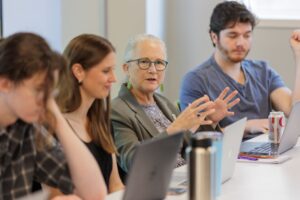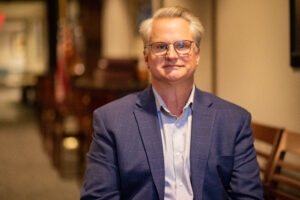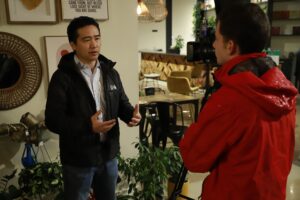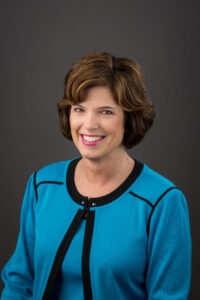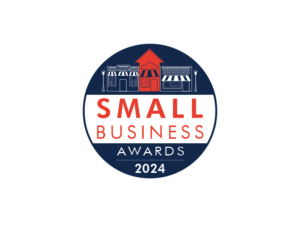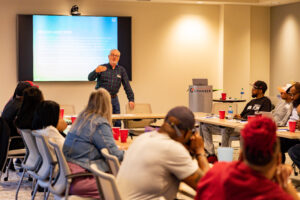eApLG83VWcY
Do you realize when you drive down West 20th Street, there is a world’s first taking place? Something so innovative and forward-thinking that architects and builders from all over will be coming here to stop and stare. Yes, it is the new Tennessee Valley Federal Credit Union (TVFCU) branch.
TVFCU hired Branch Technology, an architectural fabricator specializing in construction-scale 3D printing and a TVFCU business member, to build its latest branch. The result is the first-ever 3D-printed building facade using a patented 3D printing process called Cellular Fabrication. C-Fab® was unveiled in mid-February.

“Several years ago, I had the opportunity to visit Branch Technology when they were located in the Chattanooga Chamber of Commerce’s business INCubator funded by Hamilton County,” says Todd Fortner, president and CEO at TVFCU. “I was amazed at what could be made on a large scale with 3D printing. I immediately began to think about how we could incorporate this new technology into a future project.”
TVFCU leaders and its builder for more than 20 years, Construction Consultants, began working with Branch Technology for TVFCU’s new Southside Branch, located at 125 West 20th Street in Chattanooga. While TVFCU has a branch in downtown Chattanooga, the Southside branch fills a void in the community for a brick and mortar branch in this urban neighborhood less than 2 miles from the city center. Credit union leaders wanted to highlight the characteristics of the Tennessee Valley and to blend into the surroundings of this urban neighborhood for a truly innovative design.
Branch Technology immediately went to work developing a design concept for the building’s exterior. Platt Boyd, the founder of Branch Technology, knew well the Tennessee Valley’s scenic beauty.
After seeing the Scenic City and competing in a startup accelerator program called GigTank at The Company Lab in summer 2014, he moved his company to Chattanooga with only three employees and one robot. Their first office was at the INCubator. Today, they work from a 40,000-square foot manufacturing facility that is equipped with 15 robots.
Branch Technology’s team created a facade design that highlights the beauty of Chattanooga’s natural surroundings and incorporates TVFCU’s iconic wave branding into the design. With the design created, they began 3D printing the structure. Cellular Fabrication, or C-Fab®, is a unique printing method that allows material to solidify in open space, creating a matrix of polymer in virtually any shape.
“The undulating facade is patterned to identify entrances and expand around the building's curvature, serving as wayfinding for visitors,” says John McCabe, advanced concepts team and director of communications at Branch Technology. “Varying degrees of curvature in the sinuous facade pattern nod to TVFCU's recognizable wave logo. This project is a staple of design freedom offering a one-of-a-kind product outside the literal box of repetitive, conventional construction and facade manufacturing.”
TVFCU's Southside Branch is now open – it's TVFCU’s 20th branch and is a full-service location.
“While our competitors are closing branches, we are opening them,” Fortner says. “We are constantly looking for better ways to serve our membership. We saw a void in our service area and decided to add a branch.”
Q&A with Branch Technology
Q: What is 3D printing, and how does this process work?
A: 3D printing, or additive manufacturing, is the construction of a three-dimensional object from a CAD model or a digital 3D-model. The term 3D printing can refer to various processes in which material is deposited, joined or solidified under computer control to create a three-dimensional object, with material being added together, such as liquid molecules or powder grains being fused together. Branch Technology uses a proprietary method that uses 20x less material to create a similar volume to the traditional layer-by-layer process. We used a customized carbon fiber polymer mixture for this project. We extruded the material into the lightweight matrix structure for the facade.
Q: Why is this project unique?
A: The TVFCU project is the first time a 3D-printed composite material has been used as the exterior facade of a building.
Q: How is the product installed?
A: The industry-standard hardware makes installation a seamless experience for companies that have experience installing facade panels. The Branch Technology team includes architects with years of experience in cities like New York and Boston, developing product and installation processes very similar to what has been designed for TVFCU. The panels mate with linear hardware that is pre-installed on the building. They get lifted and set on these structural rails. Then they can be easily adjusted if need be.
Q: What type of impact will this type of technology have on the job market? Will fewer workers be needed?
A: The construction industry is actually in a deficit of skilled labor. This facade production process will not take away jobs from the already struggling job market. The prefabrication process will remove chaos from the project's site and provide products when needed. This on-demand supply chain is more efficient than using raw material onsite to customize each building element. The longer material is on-site, the more likely it is to be damaged or stolen.
Q: Can 3D printing make an entire building that is truly functional, or are we a long way from that?
A: Branch Technology has already printed 100% of a demonstration project, a roughly 3000-sq.-ft. building that includes the walls and roof. So the technology is there, but the cost is still a long way from a commodity level. Dubai has been the most aggressive city, requiring 25% of all construction to be 3D-printed by 2025. That is why there is a lot of innovation happening there. But to date, there hasn't been an entire building from foundation to roof that is 3D-printed. Buildings are a complex layering of different materials. This is why the Branch Technology composite material system is more intelligent than the solutions that create a monolithic layered wall assembly.
Q: Are the methods being used at Branch Technology revolutionizing 3D technology? What could this mean for Chattanooga's technology future? Could Chattanooga someday be the world's leader in this type of industry?
A: Chattanooga is located within an advanced manufacturing corridor from Virginia to Huntsville, Alabama. This is one of the reasons Platt Boyd founded Branch Technology here. It was an early strategic decision in the life of the company to locate in Chattanooga. The process that Branch has developed is pushing the industry to question the status quo and the performance of 3D printed construction.
Q: Do you see four-year universities like UTC offering this type of degree within its engineering school?
A: Universities already offer degrees in advanced manufacturing, computational and generative product development and robotic construction. Once you combine those offerings with trusted architecture, mechanical engineering and software development programs, you have covered a significant proportion of the Branch Technology team.
